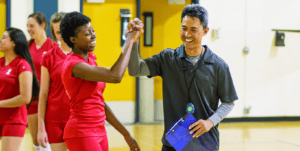PCA Resource zone
Using Effort Goals

Setting goals with athletes can help them track and celebrate progress throughout a season. Coaches should set effort-based goals with athletes so they are largely in control of achieving them. By setting effort goals, athletes can experience success in competition even if the end result doesn’t go their way. By recognizing effort, athletes will stay motivated and can learn the benefits of trying hard throughout their lives.
The Link Between Effort Goals and Outcome Goals
Outcome goals can discourage effort, especially for younger, beginner, or outmatched athletes. When an athlete consistently comes short of a result, they may struggle to recognize how they will achieve it – and can lose motivation because they may not have full control over achieving it. Well designed effort goals should, over time, move an athlete toward outcome goals. If a team focuses on effort goals and begins to achieve them, its performance will likely improve. Over time, these effort based goals can move a team closer to the outcome goals it desires.
[design element here – maybe a box or something] Ex: If a soccer coach wants their team to give up less goals (outcome goal) they can set an effort goal with their team to hustle back on defense each time possession is given away. If the team achieves the effort goal of hustling back on defense, it is much more likely that the outcome goal of letting in less goals will also be achieved.
To set and reinforce effort goals, coaches can:
- Collaborate with athletes to help them feel more connected to their own successes and invested in working towards them.
- Develop practice and competition goals. Doing so helps athletes recognize the critical importance of effective practices in preparing for competitions and gives athletes an opportunity to celebrate the many achievements that happen while learning and developing their skills.1
- Simplify the differences between effort and outcome goals.
- For example – tell the team: “Effort goals are about how hard we try and are under our control. Outcome goals are about results that we don’t necessarily have control over.”
- Focus on life skills.
- For example, set goals like – encourage a teammate with a high five 3 times during practice, or find ways to overcome a challenge by trying something new once per practice.
- Be specific about what success looks like by attaching a number to goals for each practice, game, or season.
- For example: “I will sprint into position after at least 5 out-of-bounds shots in the game.”
- Review progress towards goals often.
- During games, coaches can use time-outs, half-time, and post-game debriefs to review progress on effort goals.
- During practice, coaches can use water breaks and cool-downs to review progress.
- Give clear, concise, detailed feedback so athletes know how to continue to improve and to show you are paying attention to their development.2
- https://appliedsportpsych.org/resources/resources-for-athletes/principles-of-effective-goal-setting/
- https://blog.searchinstitute.org/helping-young-people-achieve-goals







